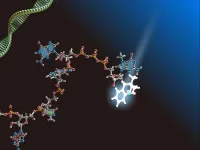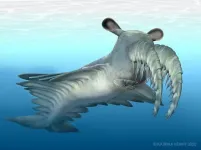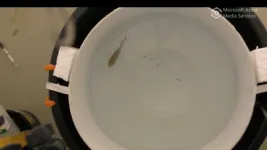(Press-News.org) A research group from Japan has developed a method to produce highly active mRNA vaccines at high purity using a unique cap to easily separate the desired capped mRNA. This ‘Purecap’ technique extracted up to 100% pure Cap2-type mRNA, which showed 3-4 times better production of the protein that stimulates the immune system. These results open up the possibility of purer vaccines with a lower risk of inflammation caused by impurities. Their findings were published in Nature Communications.
mRNA vaccines have been used successfully as therapy against variants of the coronavirus. This has given researchers hope for their future use as a cancer vaccine. However, the purity of vaccines hinders this goal because impurities can trigger the immune system. This may cause inflammation around the injection site, a common side effect of vaccination.
Impurities in mRNA vaccines are often introduced in the capping stage. During this stage, a cap structure is added that improves the translation of mRNA and protects and stabilizes it. Caps can only be added to single-stranded mRNA, so ideally a vaccine should contain 100% pure single-stranded mRNA. However, unwanted double-strands of mRNA may be present, reducing its purity.
As single- and double-stranded mRNAs have different properties, they can be separated using a technique called reversed-phase high-performance liquid chromatography (RP-HPLC). This technique separates mRNAs on the basis of their hydrophobicity or hydrophilicity, i.e., their repulsion to or attraction to water.
A research group led by Professor Hiroshi Abe (he, him), Project Assistant Professor Masahito Inagaki (he/him), and Project Associate Professor Naoko Abe (she, her) of the Graduate School of Science, Nagoya University, in collaboration with Tokyo Medical and Dental University, used a unique PureCap method to introduce a hydrophobic tag at the capping stage. The tagged mRNA was easily separated at the RP-HPLC stage. The tag was then easily removed by light treatment, resulting in a 98%-100%-pure vaccine.
“We were very excited about the result when we saw on the chart that the RP-HPLC process had separated completely the capped and uncapped RNAs,” Hiroshi Abe said. “For a coronavirus mRNA, which is 4247 bases long, we successfully used the PureCap method to produce capped mRNA with over 98% purity.”
The research group paid particular attention to a group of cap structures that exist in animal and plant cells, called Cap0, Cap1, and Cap2. Although Cap2 is found in animal and plant cells, the evaluation of its function has been difficult because there was no way to obtain pure capped mRNA to ensure a fair test.
“The Cap structure used in mRNA vaccines has so far been limited to Cap0 and Cap1 types. However, we used our technique to manufacture Cap0, Cap1, and Cap2-type structures,” Abe said. “Highly purified Cap0, Cap1, and Cap2-type mRNA synthesized using the PureCap method showed lower immunostimulatory activity compared to mRNAs synthesized using conventional techniques showing their potential use in pharmaceuticals.”
As viruses mostly produce Cap1 mRNA, the immune system is less stimulated by Cap2. This suggests that a vaccine that uses Cap2 would be less likely to cause unwanted side effects such as inflammation when it is injected. However, it would still be able to create viral proteins when transcribed that make the vaccine effective.
The group used Purecap to create Cap2 mRNA and analyzed its protein synthesis capacity. They found that Cap2 mRNA produced 3-5 times more protein than Cap1 mRNA, which would enhance the immune response. They also showed that their Cap2-type mRNAs caused lower stimulation of the inflammatory response than mRNAs synthesized using conventional techniques.
“Conventional mRNA vaccine production methods could not prepare capped mRNA with high purity, raising concerns about reduced protein synthesis and impurity-derived inflammatory reactions,” Abe said. “The PureCap method solves these problems by selectively purifying only capped mRNA. Furthermore, the Cap2-type structure created using this technique is more efficient in protein synthesis and less irritating to the immune system. This technique has the potential to improve the safety and efficacy of mRNA vaccines. It is a revolutionary advance toward the practical application of mRNA medicine, as well as deepening our understanding of the fundamentals of mRNA science."
END
Pure capped mRNA vaccine opens the door to more effective vaccines with lower chances of inflammation
2023-07-05
ELSE PRESS RELEASES FROM THIS DATE:
New understanding of how the brain processes and stores words we hear
2023-07-05
WASHINGTON – Georgetown University Medical Center neuroscientists say the brain’s auditory lexicon, a catalog of verbal language, is actually located in the front of the primary auditory cortex, not in back of it -- a finding that upends a century-long understanding of this area of the brain. The new understanding matters because it may impact recovery and rehabilitation following a brain injury such as a stroke.
The findings appear in Neurobiology of Language on July 5, 2023.
Riesenhuber’s lab showed the existence of a lexicon for written words at the base of the brain’s left hemisphere in a region ...
Similar to humans, elephants also vary what they eat for dinner every night
2023-07-05
PROVIDENCE, R.I. [Brown University] — Elephants eat plants. That’s common knowledge to biologists and animal-loving schoolchildren alike. Yet figuring out exactly what kind of plants the iconic herbivores eat is more complicated.
A new study from a global team that included Brown conservation biologists used innovative methods to efficiently and precisely analyze the dietary habits of two groups of elephants in Kenya, down to the specific types of plants eaten by which animals in the group. Their findings on the habits of ...
Endometriosis linked to reduction in live births before diagnosis of the disease
2023-07-05
Endometriosis is linked to a reduction in fertility in the years preceding a definitive surgical diagnosis of the condition, according to new research published today (Wednesday) in Human Reproduction [1], one of the world’s leading reproductive medicine journals.
In the first study to look at birth rates in a large group of women who eventually received a surgical verification of endometriosis, researchers in Finland found that the number of first live births in the period before diagnosis was half that of women without the painful condition. ...
Apex predator of the Cambrian likely sought soft over crunchy prey
2023-07-05
Biomechanical studies on the arachnid-like front “legs” of an extinct apex predator show that the 2-foot (60-centimeter) marine animal Anomalocaris canadensis was likely much weaker than once assumed. One of the largest animals to live during the Cambrian, it was probably agile and fast, darting after soft prey in the open water rather than pursuing hard-shelled creatures on the ocean floor. The study is published today in the journal Proceedings of the Royal Society B.
First discovered in the late 1800s, Anomalocaris canadensis—which means “weird shrimp from Canada” in Latin—has long been thought to be responsible ...
Warmer and murkier waters favour predators of guppies, study finds
2023-07-05
Changes in water conditions interact to affect how Trinidadian guppies protect themselves from predators, scientists at the University of Bristol have discovered.
Known stressors, such as increased temperature and reduced visibility, when combined, cause this fish to avoid a predator less, and importantly, form looser protective shoals.
The findings, published today in the journal Proceedings of the Royal Society B, show guppies’ responses are more affected by the interaction of these stressors than if they acted independently.
Natural ...
Vineyard fungicides pose a threat to survival of wild birds
2023-07-04
New research reveals that wild birds living in vineyards can be highly susceptible to contamination by triazole fungicides, more so than in other agricultural landscapes. Exposure to these fungicides at a field-realistic level were found to disrupt hormones and metabolism, which can impact bird reproduction and survival.
“We found that birds can be highly contaminated by triazoles in vineyards,” says Dr Frédéric Angelier, Senior Researcher at the French National Center for Scientific Research, France. “This contamination was much higher in vineyards relative to other crops, emphasizing that contaminants may especially put birds at risk in these ...
World’s most threatened seabirds visit remote plastic pollution hotspots, study finds
2023-07-04
UNDER STRICT EMBARGO UNTIL 16:00 LONDON TIME (BST) / 11:00 (US ET) ON TUESDAY 4TH JULY 2023
Analysis of global tracking data for 77 species of petrel has revealed that a quarter of all plastics potentially encountered in their search for food are in remote international waters – requiring international collaboration to address.
The extensive study assessed the movements of 7,137 individual birds from 77 species of petrel, a group of wide-ranging migratory seabirds including the Northern Fulmar and European Storm-petrel, and the Critically Endangered Newell’s Shearwater.
This is ...
Sea of plastic: Mediterranean is the area of the world most at risk for endangered seabirds
2023-07-04
New study reveals the areas most at risk of plastic exposure by the already endangered seabirds.
The study, now published in Nature Communications, brings together more than 200 researchers worldwide around a pressing challenge, widely recognized as a growing threat to marine life: the pollution of oceans by plastic. Coordinated by Dr. Maria Dias, researcher at the Centre for Ecology, Evolution and Environmental Changes (cE3c) at the Faculty of Sciences of the University of Lisbon (Ciências ULisboa), ...
Omega-3 oil counteracts toxic effects of pesticides in pollinators
2023-07-04
New research suggests that the use of an omega-3 rich oil called “ahiflower oil” can prevent damage to honey bee mitochondria caused by neonicotinoid pesticides. This research is part of an ongoing project by PhD student Hichem Menail of the Université de Moncton in New Brunswick, Canada.
“Pesticides are a major threat to insect populations and as insects are at the core of ecosystem richness and balance, any loss in insect biodiversity can lead to catastrophic outcome,” says Mr Menail, adding that pesticide-related pollinator declines are also a huge concern for food crops globally.
Imidacloprid, ...
Global efforts to reduce infectious diseases must extend beyond early childhood
2023-07-04
Global efforts to reduce infectious disease rates must have a greater focus on older children and adolescents after a shift in disease burden onto this demographic, according to a new study.
The research, led by Murdoch Children’s Research Institute and the Institute for Health Metrics and Evaluation, has found that infectious disease control has largely focused on children aged under five, with scarce attention on young people between five and 24 years old.
Published in The Lancet, the study found three million children and adolescents die from infectious diseases every year, equivalent to one death every 10 seconds. It looked at data across 204 countries ...






